Living off-grid in the winter presents a unique set of challenges and rewards. As temperatures drop, daylight hours shorten, and resources become scarce, the off-grid experience transforms into a test of both resilience and adaptability. However, winter also offers an unmatched opportunity to connect with the natural world, appreciate the crisp air and clear night skies, and embrace a slower, more deliberate way of life.
Off-grid winter living requires careful preparation and foresight. Insulation, reliable heating, and sustainable water sources become critical, as does ensuring your home can withstand harsh weather conditions. Despite the difficulties, there’s a profound beauty in waking up to snow-covered landscapes, witnessing the cycle of the seasons, and finding creative ways to remain comfortable amidst the cold. The balance between hardship and the rewards of a simpler way of life makes off-grid winter living a deeply fulfilling choice for those willing to embrace it.
In this guide, you will learn about the preparations needed to not only survive but thrive in these conditions. Discover how to winterise your home, manage food supplies, keep warm, and stay healthy. Whether you’re living in a traditional off-grid home or adopting a more nomadic approach, this article will provide essential tips and strategies to ensure your winter off-grid experience is a successful one.
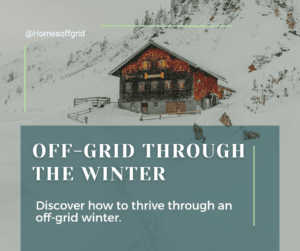
Preparing Your Off-Grid Home for Winter
Preparing your home for winter is one of the most crucial steps in ensuring you can endure the colder months while living off-grid. Insulation, heating, water management, and energy solutions all need to be carefully considered to maintain a comfortable and functional home environment during the season.
Insulation and Heating
Insulating your home is vital to retain warmth and conserve energy throughout the winter. Start by focusing on key areas: walls, windows, floors, and roofs. Insulating these parts of your home will minimise heat loss and make it easier to maintain a stable indoor temperature. Draught-proofing windows and doors, as well as adding insulation to floors and ceilings, can significantly reduce cold air infiltration. Additional thick curtains and rugs can provide additional insulation. It’s also important to inspect and maintain your home’s overall structure before the cold sets in. Repair any cracks, leaks, or weaknesses that could cause issues in harsher conditions.
When it comes to heating, wood stoves, rocket stoves and diesel heaters are excellent choices for off-grid homes. A well-maintained wood stove can provide consistent warmth, while also serving as a space to cook or heat water. Rocket stoves, known for their high efficiency and low fuel consumption, offer another option for those wanting to minimise firewood use. While diesel heaters require purchasing fuel, they are efficient, quick to warm up and make it easy to control the temperature. Ensure you have access to sufficient firewood or another fuel source to last the winter months. For homes with larger spaces, consider incorporating passive heating techniques, such as south-facing windows to capture sunlight.
Water Systems
Water systems are prone to freezing during the winter, making it crucial to safeguard your water supply. Insulating exposed pipes and installing frost-proof taps can prevent costly and inconvenient damage. If you rely on rainwater harvesting, consider heated or insulated storage tanks to stop your water from freezing. Snowmelt can also provide a sustainable water source, though it requires melting and filtering before use.
Winter water conservation is equally important. Simple strategies, such as reusing greywater for non-drinking purposes and limiting excess usage, will help ensure your water supply lasts longer. For those living in extremely cold areas, pre-emptive water storage in large, insulated containers may be necessary.
Energy Solutions for Winter
Energy management becomes more challenging in winter, with shorter days and weaker sunlight. Solar panels can still generate power, but to make the most of limited sunlight, it’s crucial to keep them clean of snow and angled optimally. Additionally, pairing solar power with wind turbines or small hydro generators can offer backup energy when sunlight is scarce.
Sufficient battery storage plays a key role in off-grid winter energy solutions, allowing you to store power during the day for use at night. One key thing to remember is that while more battery capacity gives you more leeway for power usage, it can be difficult to recharge larger batteries. Having a backup generator, preferably running on renewable fuels, is another useful precaution. To conserve energy, adopt power-saving techniques, such as using energy-efficient appliances, limiting lighting to necessary areas, unplugging devices when not in use and charging items when there is a higher energy input.

Food and Supplies: Stocking Up for Winter
Ensuring you have enough food and essential supplies is key to surviving the colder months when living off-grid. Winter weather can limit access to fresh food and resources, so careful planning and stocking up will help you stay prepared and self-sufficient.
Food Preservation Techniques
Stocking up on preserved foods is essential for off-grid winter living. Techniques such as canning, fermenting, drying, and freezing can extend the shelf life of various foods, allowing you to store enough for the entire winter season. Some of the best items to preserve include root vegetables, fruits, meats, and beans. Canning or fermenting vegetables like carrots, potatoes, and cabbage ensures a steady supply of nutritious food, while dried fruits, herbs, and spices offer variety and essential nutrients. Frozen goods, if you have the capacity, can supplement your stores, especially meats and prepared meals.
By having a well-balanced range of preserved foods, you reduce the need to rely on external resources during the winter, making your off-grid experience more sustainable. For more detailed information on food preservation methods, click here.
Growing and Foraging During Winter
Though challenging, maintaining a winter garden or greenhouse is still possible. Hardy crops like kale, spinach, and carrots can survive lower temperatures and provide fresh produce throughout the winter. Indoor gardening, using pots or hydroponic systems, is another option if you have sufficient space. Plants like herbs, lettuce, and microgreens can thrive indoors with sufficient light, offering a fresh, nutritious supplement to preserved foods.
Foraging is another method to gather food during the winter months, though it requires knowledge and caution. Nuts, berries, and certain mushrooms can still be found in the colder months, but foragers must be cautious. Many edible mushrooms, such as winter chanterelles, have poisonous look-alikes, so only experienced foragers should attempt mushroom harvesting. Always double-check foraging sources and, if in doubt, avoid consuming unknown foods.
Essential Supplies to Keep On Hand
Aside from food, it’s vital to stock up on essential supplies for off-grid winter living. Start by ensuring you have a comprehensive tool kit for basic repairs and upkeep of your home. This should include items like a hammer, saw, multi-tool, and axe for firewood preparation. Medical supplies are another priority – keep a well-stocked first-aid kit with items like bandages, antiseptics, and any personal medications you may need.
Warm clothing and blankets are non-negotiable. Ensure you have enough thermal wear, woollen socks, hats, and gloves, as well as heavy-duty outer layers to withstand the cold. Maintaining warmth in emergency situations is crucial, so having extra blankets, hot water bottles and insulated clothing on hand can make a significant difference.
Managing Cold and Snow in Off-Grid Winter Living
Living off-grid in the winter means not only preparing for the cold but also managing snow and other winter-related challenges. From firewood collection to emergency preparedness, staying ahead of these tasks is essential for comfort and safety during the colder months.
Firewood Collection and Management
For those relying on wood-burning stoves or fireplaces, firewood is the lifeblood of off-grid winter living. Gathering, chopping, and storing enough firewood to last the entire season should be a priority long before the first snowfalls. Collect your firewood in late summer or early autumn to give it time to dry out and cure, ensuring it burns efficiently. Hardwood varieties such as oak, ash, and birch are ideal for longer-burning, hotter fires, while softer woods like pine may be used for kindling but burn much faster.
Proper storage is key to maintaining dry firewood throughout the winter. Stack your wood in a covered area, keeping it off the ground to prevent moisture absorption. Regularly inspect your supply throughout the season to ensure it remains dry, as wet wood can create more smoke and burn inefficiently, reducing the heat output and leading to creosote build-up in chimneys.
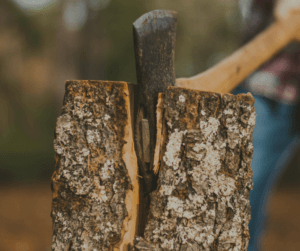
Snow Management and Access
Winter snow can create barriers to mobility and access around your property. Clearing paths and maintaining access routes is not only a matter of convenience but also safety. Regularly shovel or plow paths to critical areas like firewood storage, water sources, and your main entrance. Also, make sure that roofs are clear of heavy snow build-up, as excessive weight can cause structural damage or leaks.
If you rely on a vehicle, maintaining access to roads or parking areas is essential. Snow chains, shovels, and a snowblower, if available, can make the task easier. Regularly check and clear routes to ensure you can leave your property in case of emergencies or supply runs.
Winter Weather and Emergency Preparedness
Winter brings the risk of extreme weather, including snowstorms, blizzards, and ice. Preparing for such events ensures you can remain safe and self-sufficient during extended periods of harsh conditions. Keep a well-stocked emergency kit that includes essentials like non-perishable food, water, extra blankets, and first-aid supplies. A reliable source of communication, such as a battery-powered or hand-crank radio, is crucial for receiving weather updates and emergency broadcasts.
Communication is also vital for personal safety, especially when venturing outdoors. If you plan to forage, hike, or perform other outdoor tasks, always let someone know where you are going and when you plan to return. In case of an emergency, this ensures others can raise the alarm if you’re overdue or unreachable.
Winter Preparations for Your Off-Grid Property
Preparing your land and livestock for the winter months is vital for maintaining a self-sufficient property. As the colder season approaches, being well-prepared can help prevent weather-related damage, protect animals, and ensure the continued productivity of your land.
Preparing the Land for Winter
Winter can be harsh on the land, and ensuring that your property is prepared for the coming months can save you from dealing with costly repairs or lost productivity later. Begin by clearing ditches and drains to prevent waterlogging and flooding, which are common winter issues in many regions. By maintaining a proper drainage system, you can avoid excess water accumulation, which can lead to soil erosion or even structural damage to buildings.
Additionally, winterising your vegetable plot is essential if you want to protect any remaining crops or prepare for early spring planting. Cover any frost-sensitive plants with cloches, row covers, or mulch. Mulching garden beds can also help to lock in moisture and protect the soil structure during freezing conditions. Consider planting winter-hardy vegetables, such as kale or cabbage, if you’re looking to continue growing food through the colder months. Survey any trees in proximity to your buildings, animals, or access routes for weak branches or roots. Heavy snow or storms could lead to fallen trees and branches which could cause damage or harm.
Caring for Animals During Winter
The well-being of your animals is critical to the success of your off-grid property in winter. As temperatures drop, you’ll need to ensure that their shelters are properly insulated, dry, and warm. Provide extra bedding materials, such as straw, to offer added warmth, and ensure that barns or coops are well-sealed to prevent drafts but still allow ventilation to avoid moisture buildup.
Another important task is ensuring that your animals have consistent access to water. In freezing temperatures, water supplies can quickly ice over. Consider investing in heated water containers or regularly breaking the ice to keep water available. You’ll also need to stockpile extra food and supplements to ensure that your animals maintain their energy levels during the cold months, especially if grazing areas become limited due to snow or frost.
Taking these steps to prepare both the land and your animals will not only help your property weather the winter but also ensure a strong and productive start when the warmer seasons return.
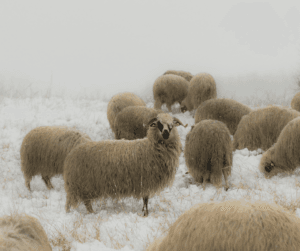
Nomadic Off-Grid Winter Living
While living off-grid in a fixed location during winter presents its challenges, nomadic off-grid living in cold climates adds a layer of complexity. Whether you’re on a boat, in a vehicle, or in a more mobile setup like a yurt, adapting your lifestyle for winter is crucial, unless you intend to migrate with the seasons. Each type of nomadic living comes with its own unique winter considerations for insulation, heating, and movement.
Living on Canal Boats in Winter
Winter on a canal boat, whether it’s a narrowboat or a widebeam, can be both serene and demanding. Proper insulation is key to maintaining comfort when temperatures drop. Adding extra insulation to windows, floors, and walls can help retain heat, while thick curtains or thermal blinds can prevent drafts. Additionally, wood stoves or diesel heaters are effective ways to heat a boat, ensuring you stay warm throughout the season.
One of the biggest challenges of canal life in winter is dealing with frozen or blocked waterways. Ice or fallen trees from storms can prevent movement, restricting access to services or fuel. Preparing in advance is essential. Make sure to stock up on supplies and plan for longer stays in a single location when canals freeze over. Having a reliable secondary heating source, such as a portable heater, ensures you’re not entirely dependent on one system during prolonged cold spells. You may want to consider moving onto a marina for winter. This way you have access to mains power and other services if necessary.
Living in Vehicles Through Winter
Living in vehicles of any size during winter requires careful preparation to ensure comfort in colder conditions. Insulating your vehicle is crucial; adding insulation to walls, floors, and ceilings helps maintain a warm environment. Thermal window coverings and sealing gaps around doors and windows can also prevent heat loss.
Finding a safe and warm place to park is another challenge. You must be conscious of how snow and ice might affect your access and exit, but also consider the risks caused by flooding or treefall during storms. Winter campgrounds or designated parking areas with access to electricity are a great option especially for your first winter. This allows you to run extra heaters or other equipment and gives you extra support if you need it. If you’re staying off-grid, ensure your heating system is efficient and reliable. Diesel heaters or log burners are often used in vehicles for this purpose. In extreme cold, consider supplementing these with portable heaters or extra blankets to stay warm through the night. Ensure your water supply is well insulated and preferably inside your vehicle to prevent it from freezing.
Sailing Boats in Cold Climates
Preparing a sailboat for winter is essential if you’re living on the water in colder regions. Insulating the boat’s interior with thermal curtains or foam insulation is one of the first steps in keeping the cabin warm. Heating options like diesel or wood stoves work well on sailboats, though it’s important to ensure proper ventilation to prevent condensation and moisture build-up.
Navigating icy waters presents a significant challenge. Ice can damage a boat’s hull, and many harbours may become inaccessible. Plan your routes carefully and consider mooring in sheltered areas where the risks of ice formation and strong winds are lower. In some cases, you may need to stay in one location for extended periods to avoid navigating dangerous conditions.
Yurts and Tent Living in Winter
While yurts and tents offer a unique way to live off-grid, they require serious preparation to handle winter conditions. Insulating the walls and floors of a yurt with wool or thermal blankets is essential for retaining heat. A wood stove or a diesel heater can provide ample warmth, but it’s crucial to manage ventilation carefully to avoid carbon monoxide build-up in enclosed spaces.
For those living in tents or other temporary structures, staying warm and dry is a priority. Choose high-quality, four-season tents designed for winter conditions and use insulated sleeping bags rated for sub-zero temperatures. Keeping the tent’s interior dry is equally important, as moisture build-up from condensation or snow can lead to discomfort and heat loss. If you are using a more spacious tent such as a yurt you could consider pitching a smaller tent inside this for sleeping to maximise warmth and comfort.
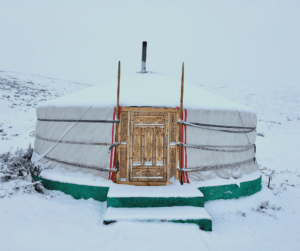
Mental and Physical Well-being in Winter Off-Grid Living
Maintaining both physical and mental well-being is essential for thriving during winter off-grid living. Cold conditions bring unique health challenges, and the isolation that often comes with remote winter living can affect mental health. However, with some foresight and self-care strategies, you can navigate these difficulties effectively.
Staying Fit and Healthy in Cold Conditions
Cold weather places additional stress on the body, and protecting yourself from its effects is crucial. Hypothermia and frostbite are two of the most serious risks during extended exposure to freezing temperatures. Layering your clothing – starting with moisture-wicking base layers and insulating mid-layers, topped with waterproof and windproof outerwear – helps regulate body heat. It’s also important to keep extremities warm with gloves, hats, and insulated boots to prevent frostbite.
Staying active is another important aspect of winter health. While you may not be able to engage in your usual outdoor activities, there are plenty of ways to keep moving during the colder months. Indoor exercises such as yoga, resistance training, or even using body-weight exercises like push-ups and squats can help maintain fitness. If space allows, you might also incorporate aerobic exercises like jumping jacks or stationary running.
Don’t overlook the need for a balanced diet in winter, as it plays a role in sustaining energy levels and immune function. Make sure your food stores include nutrient-rich options like canned vegetables, legumes, and whole grains to maintain your body’s strength throughout the season.
Managing Mental Health and Isolation
Isolation can be one of the toughest aspects of winter off-grid living, especially in remote areas where contact with others is limited. Shorter daylight hours and being confined indoors due to harsh weather can lead to feelings of loneliness or even seasonal affective disorder (SAD), which is common in colder climates.
It’s important to create routines that bring structure to your day. Engaging in daily activities, whether it’s maintaining your home, tending to indoor plants, or working on a creative project, can help reduce feelings of aimlessness. Try to schedule time outside whenever possible, as exposure to natural light can improve your mood and energy levels, even if it’s just a short walk from your front door.
Staying connected with others, even from a distance, is equally important. Regularly reaching out to family and friends via phone or online can help combat feelings of isolation. If you’re near a community of like-minded individuals living off-grid, consider meeting up for social gatherings or exchanging resources.
Additionally, mindfulness practices such as meditation or journaling can help you manage stress and maintain emotional balance. These practices can be particularly beneficial during the long, dark winter months when mental health challenges may become more pronounced.
Conclusion
Living off-grid in winter presents a unique blend of challenges and rewards. From battling freezing temperatures and managing limited daylight to securing reliable heating, water, and food supplies, the need for thorough preparation is clear. Ensuring your home is well-insulated, stocking up on essential supplies, and having a plan for emergencies are all crucial steps to weather the winter months. Whether you’re living in a fixed off-grid home or embracing a nomadic lifestyle in a canal boat, vehicle, or tent, careful planning is essential to make the experience sustainable and comfortable.
While the challenges are considerable, the rewards of off-grid winter living can be deeply fulfilling. Embracing a slower pace of life, being attuned to nature’s rhythms, and developing greater self-reliance are just some of the benefits. For those who prepare well and are ready to adapt, the beauty of snow-covered landscapes, the satisfaction of self-sufficiency, and the connection to the natural world make off-grid living in winter an adventure like no other.
With the right mindset and planning, you can not only survive but thrive in these conditions, discovering the immense joys that come from a more sustainable and mindful way of life.
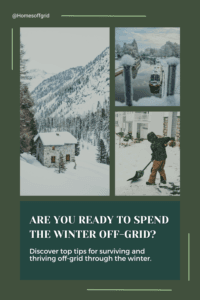
To find out more about off-grid living return to our Reading Room.


